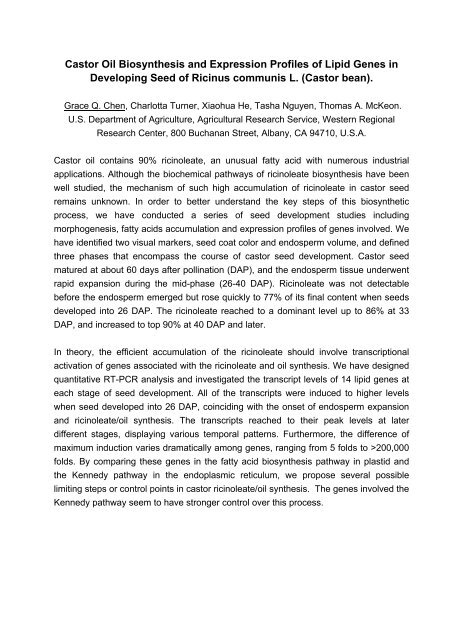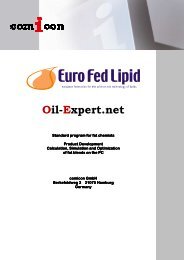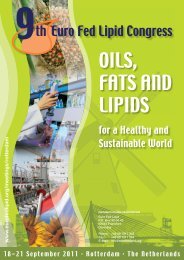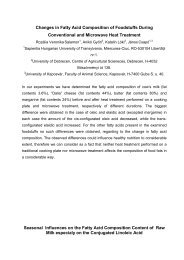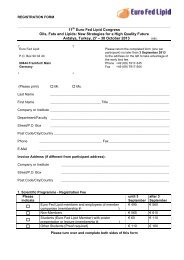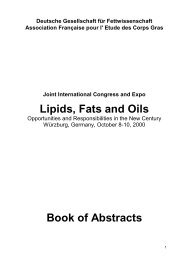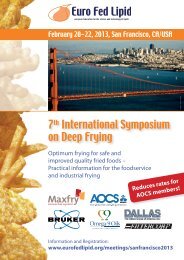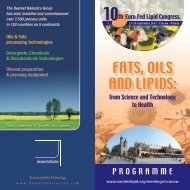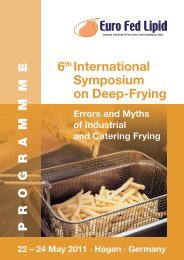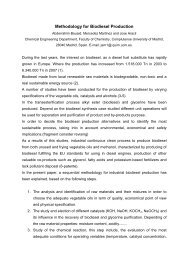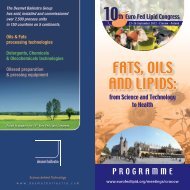Abstracts now available online - Euro Fed Lipid
Abstracts now available online - Euro Fed Lipid
Abstracts now available online - Euro Fed Lipid
You also want an ePaper? Increase the reach of your titles
YUMPU automatically turns print PDFs into web optimized ePapers that Google loves.
Castor Oil Biosynthesis and Expression Profiles of <strong>Lipid</strong> Genes in<br />
Developing Seed of Ricinus communis L. (Castor bean).<br />
Grace Q. Chen, Charlotta Turner, Xiaohua He, Tasha Nguyen, Thomas A. McKeon.<br />
U.S. Department of Agriculture, Agricultural Research Service, Western Regional<br />
Research Center, 800 Buchanan Street, Albany, CA 94710, U.S.A.<br />
Castor oil contains 90% ricinoleate, an unusual fatty acid with numerous industrial<br />
applications. Although the biochemical pathways of ricinoleate biosynthesis have been<br />
well studied, the mechanism of such high accumulation of ricinoleate in castor seed<br />
remains unk<strong>now</strong>n. In order to better understand the key steps of this biosynthetic<br />
process, we have conducted a series of seed development studies including<br />
morphogenesis, fatty acids accumulation and expression profiles of genes involved. We<br />
have identified two visual markers, seed coat color and endosperm volume, and defined<br />
three phases that encompass the course of castor seed development. Castor seed<br />
matured at about 60 days after pollination (DAP), and the endosperm tissue underwent<br />
rapid expansion during the mid-phase (26-40 DAP). Ricinoleate was not detectable<br />
before the endosperm emerged but rose quickly to 77% of its final content when seeds<br />
developed into 26 DAP. The ricinoleate reached to a dominant level up to 86% at 33<br />
DAP, and increased to top 90% at 40 DAP and later.<br />
In theory, the efficient accumulation of the ricinoleate should involve transcriptional<br />
activation of genes associated with the ricinoleate and oil synthesis. We have designed<br />
quantitative RT-PCR analysis and investigated the transcript levels of 14 lipid genes at<br />
each stage of seed development. All of the transcripts were induced to higher levels<br />
when seed developed into 26 DAP, coinciding with the onset of endosperm expansion<br />
and ricinoleate/oil synthesis. The transcripts reached to their peak levels at later<br />
different stages, displaying various temporal patterns. Furthermore, the difference of<br />
maximum induction varies dramatically among genes, ranging from 5 folds to >200,000<br />
folds. By comparing these genes in the fatty acid biosynthesis pathway in plastid and<br />
the Kennedy pathway in the endoplasmic reticulum, we propose several possible<br />
limiting steps or control points in castor ricinoleate/oil synthesis. The genes involved the<br />
Kennedy pathway seem to have stronger control over this process.


